- Common Flycatcher
- Centipede Nutrition
- Centipede in the house
- Centipede and Scolopendra
- Centipede bite
A domestic centipede looks completely unattractive, and besides, it runs and bites quickly, which is why many people are afraid of it. Whether there is a danger from her bite for a person’s life and whether it is necessary to fight it, the answers to these questions will interest any homeowner.
Who is a centipede?
The biological name of this creature is the common flycatcher or domestic centipede. According to the classification, the centipede is not an insect, but belongs to the group of arthropods, of the same class, and tracheal type. In nature, there are thousands of varieties of millipedes. Their habitat is humid and darkened places: foliage, shelters under bark and stones, etc.
Millipedes go hunting at night, and hide during the day. The body of an adult centipede is divided into 15 segments, each of which has legs. Their sizes along the body are different: closer to the tail, the legs become longer, which allows them not to get entangled when moving.
Outwardly, it is difficult to determine where her head is and where the back is. In addition, the front pair of legs evolved and turned into leg jaws, designed to capture prey.
The flycatcher has a chitinous cover and a flattened body shape. Small hairs are located over the entire surface of the body, which is why some people call them shaggy centipedes. The average length is 3-4 cm, sometimes larger individuals up to 6 cm are also found.
Interesting!
The speed of movement of a home flycatcher can reach 40-60 cm per second, such a fast-moving creature often scares ignorant and nervous people. They can move both on horizontal and vertical surfaces: on the floor, walls or ceiling. Number of limbs depends on the type of millipede and can reach 354 pieces.
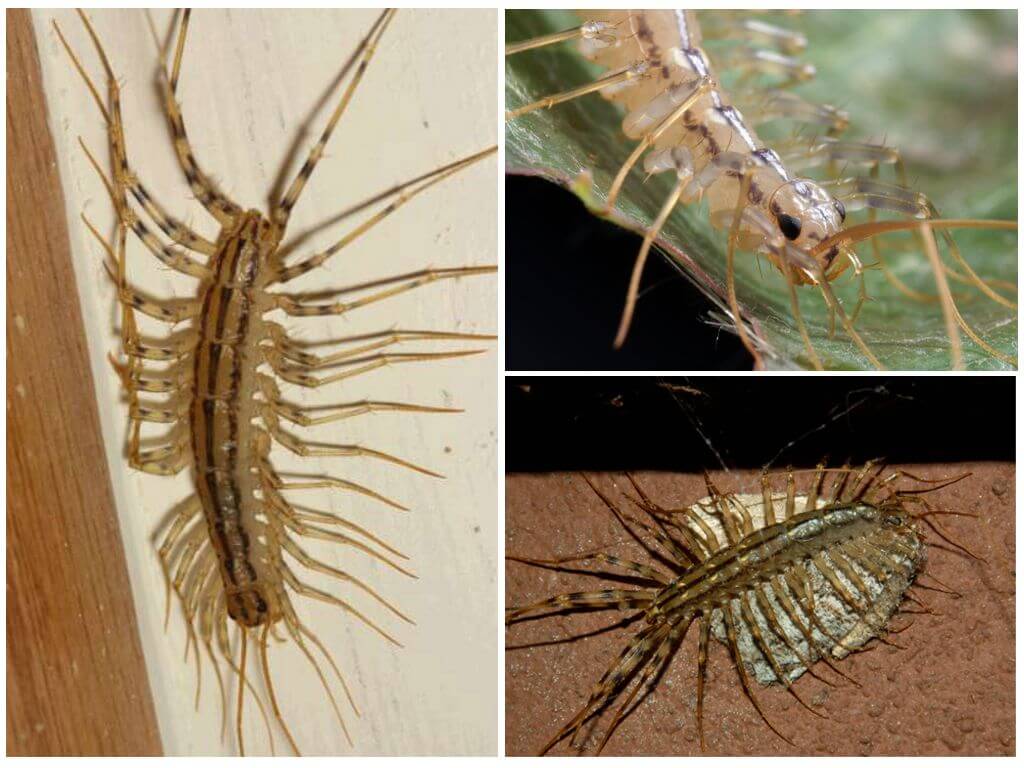
As you can see from the description and photo of the centipede, on her head are located:
- faceted eyes that perfectly see;
- long mustache-catchers, resembling a whip in shape, with their help, all environmental changes are observed;
- the mustache consists of 500-600 segments and react to temperature changes, help to explore and navigate in space, find safe places.
The color of an adult is gray-yellow, brown, 3 purple or black stripes pass on the back. In the cold season, flycatchers creep into secluded corners and freeze in order to "wake up" in the spring and again return to an active life.
Nutrition and Reproduction
The common centipede is a carnivorous predator that preys on pests: flies, ants , cockroaches, flea, bedbugs. In nature, large individuals also feed on small lizards, frogs, spiders, and worms.
When attacking, she uses her front jaw, which is connected to the poisonous glands. Having bitten the victim, the flycatcher paralyzes it and gradually eats. Having caught several insects at once, the home flycatcher eats them in turn, holding the rest with numerous legs.
Interesting!
The toxins released by the centipede have a pungent odor that scares off other predators. Therefore, even after killing a flytrap, not every animal wants to eat it.
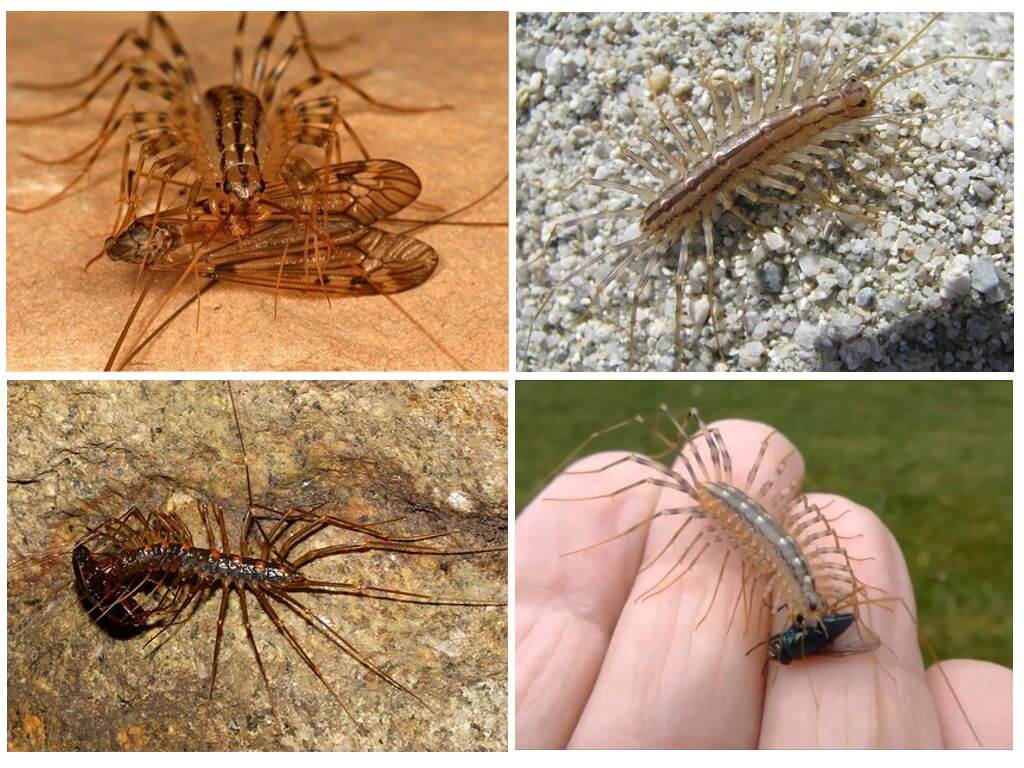
Centipedes breed in a very original way. At a suitable period, the males, when meeting with the female, lay a spermatophore in the form of a lemon, then push the female towards it, which picks it up with their appendages. Then the female lays 50-60 eggs protected by a special sticky composition in the prepared hole. After that, the flycatcher-mother sits with her whole body on the masonry and waits for the maturation of her offspring. “Hatching” eggs lasts several weeks, and all this time the female does not move away from the nest, practically starving.
The hatched babies are white or transparent in color and have 4 pairs of legs, their number will subsequently be added to 15 after each regular molt, when arthropods drop their old chitinous shell and acquire a new one. Life expectancy is 3-7 years.
Important!
For humans, the poison of the centipede is not dangerous. The only exceptions are those who are prone to allergic reactions to insect bites. They may have a slightly swollen bite site, and fever. Centipedes cannot tolerate any infections.
The homeland of these arthropods is the northern regions of Africa, the Middle East, and the south of Europe. Several hundred species of centipedes are calculated in the world, many of which have not yet been studied by biologists. In the CIS, insects similar to centipedes can be found in the southern regions of Russia, the Caucasus, Crimea, Kazakhstan.
How do centipedes get into an apartment
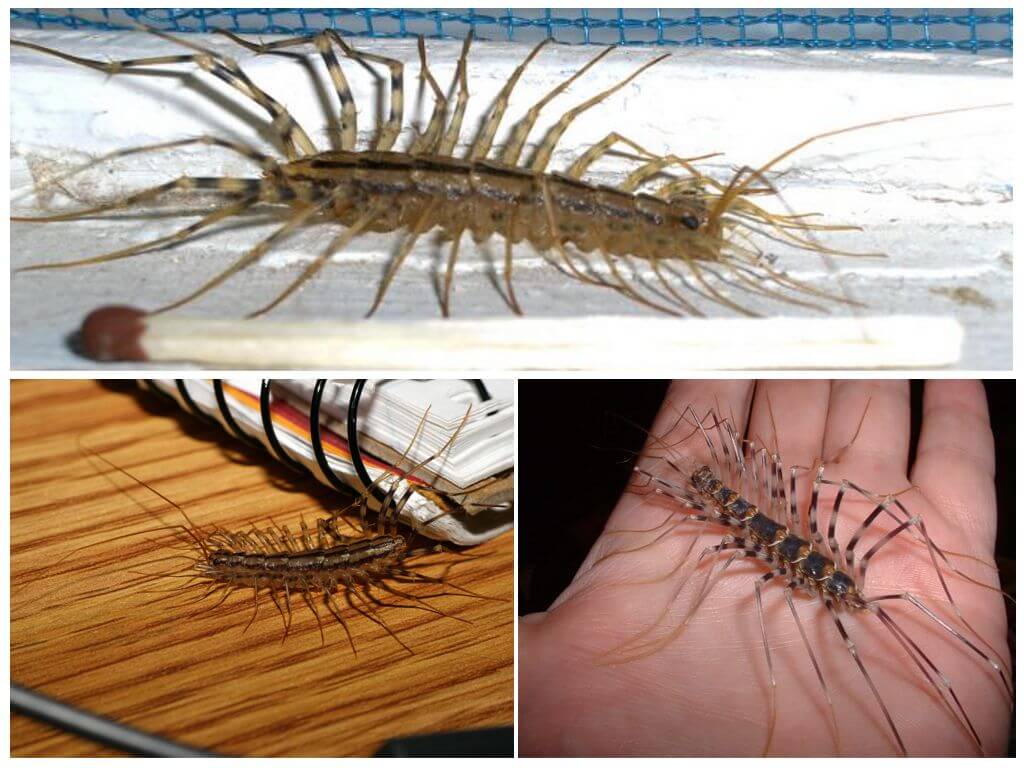
Brown centipedes come to homes and apartments in search of food or with the advent of the cold season. If there is enough food in the form of insects in the room, then they can settle for a long time. Most often they can be found in the basements of private houses, in basement rooms or in the underground floors of high-rise buildings. They prefer to hunt in the dark, but can be active during the day.
Factors Attracting Home Flycatchers to a House or Apartment:
- high humidity and dampness;
- faulty or leaking water pipes;
- many small insects in the room;
- bad light.
The most favorable places for settling all varieties of domestic flycatchers: cellars, bathroom and toilet, underground.
The benefits and harms of flytraps
Knowing what a centipede looks like and seeing it in your apartment, in a country house or in a private house, you should not be scared and immediately strive to destroy it. This creature does no harm to wallpaper, clothing, furniture or food in the kitchen. It will never attack a person for no reason. However, few owners will agree to live next to such unsightly and nimble neighbors, so they try from them get rid.
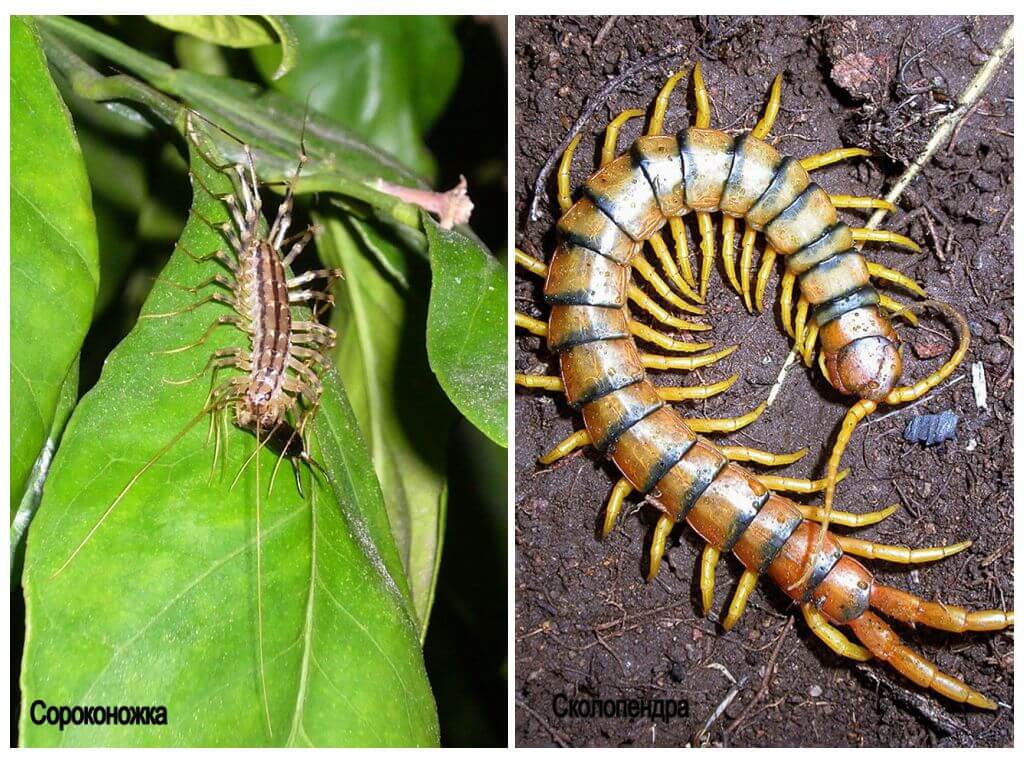
If domestic flytraps are wound up on the territory of the infield or in the beds, then there is no need to fight them at all, because they will be useful there by regularly destroying garden pests and their larvae.
On a note!
The most poisonous centipedes are scolopendra belonging to the same class of arthropods; they live only in the southern regions of Russia, as well as in tropical countries. The larger its size, the more toxic the bite and its negative consequences will be.
Large centipedes and scolopendra up to 20 cm in size, however, they live in countries of Asia, America and others, preferring a warm tropical climate.
Symptoms of intoxication after a bite of a centipede (photo below):
- severe pain at the site of the bite, itching and burning;
- swelling and redness of the skin;
- swollen lymph nodes;
- headache, palpitations, nausea and vomiting, anxiety.
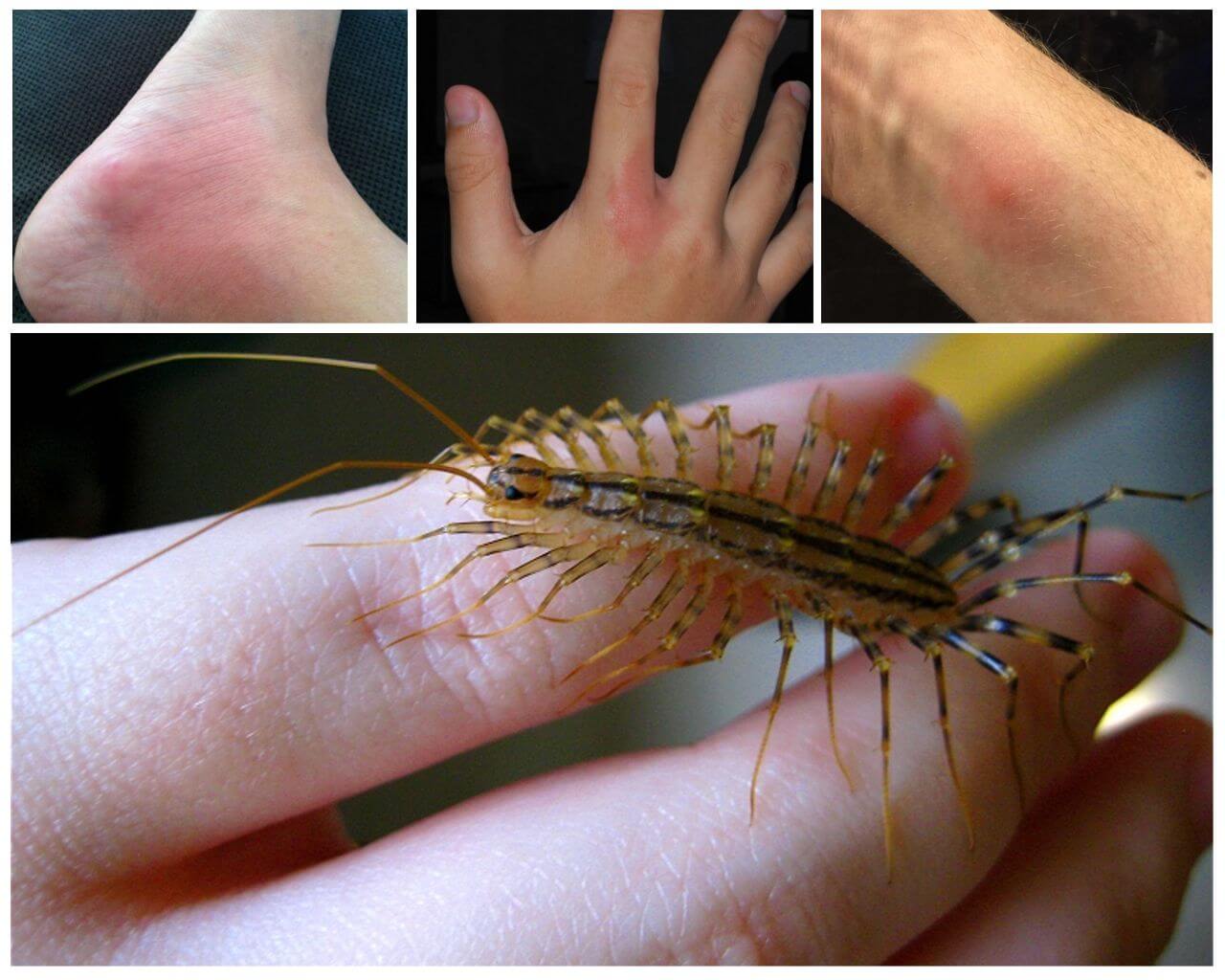
When such signs appear, it is necessary to treat the wound with a disinfectant and take antihistamines.
Fighting centipedes in the house
Fighting with home-caught flytraps settled in the house is best done with preventive methods.Given her favorite habitat and knowing what centipedes eat, it is possible to create all the conditions for them to be uncomfortable in the house:
- in apartments, the number of such arthropods is minimal, so it will be enough to kill a few pieces, which will help to remove them;
- repair water pipes in office rooms, dry and thoroughly clean storerooms, basements, etc.
- remove all pests from the house, i.e. get rid of prey available for domestic flycatchers;
- block the access paths of arthropods, closing all the cracks in the windows, doors, along the baseboards and the foundation, put a mesh in the ventilation;
- repair wooden floors, remove cracks where house flytraps like to settle, cover them with varnish or mastic, the smell of which is unbearable for them;
- avoid the presence of water or high humidity in pots and pallets of indoor flowers, where centipedes like to settle in comfort.
Adhesive tapes, which are used against flies and other insects, will not be able to catch domestic centipedes, because if they stick to it with their paws, it will simply run away without a torn limb. Subsequently, a new leg will grow in the flytrap. Food lures also do not act on them, because they do not consume any food except the insects killed by them.
If no measures help get rid of the unpleasant arthropod neighbors, then you can use insecticidal aerosols intended for domestic parasites.
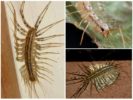
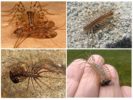
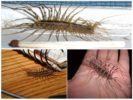
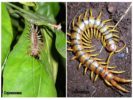
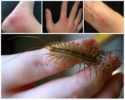




I sometimes meet them, I catch them in a jar and release them into the wild. They do not look very nice, my wife is afraid of me, and the children squeal. But you do not need to kill them, because they get into the house only by hunting for prey.
I am terribly afraid of such fast-moving insects, it takes trembling directly. It’s better to beat them right away.
Girl, read the article carefully. These centipedes are useful representatives of the fauna that destroy various harmful insects in nature and in homes.
I saw large millipedes (they are also called scolopendras) in the Crimea, they look creepy and move in zigzags, like snakes. She crawled into our room, we had to catch and crush so that she would not bite the children.
We have centipedes living in the country, a lot, sometimes you have to adjust the number, otherwise it will fall on your head at night - a nightmare, it will be a dream for a long time!